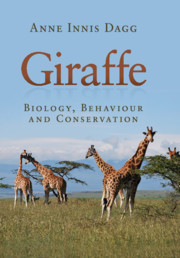Book contents
- Frontmatter
- Dedication
- Contents
- Preface
- Acknowledgements
- List of abbreviations
- 1 Time-line of giraffe
- 2 The giraffe’s environment
- 3 Feeding in the wild
- 4 Social behaviour and populations
- 5 Individual behaviours
- 6 External features
- 7 Anatomy
- 8 Physiology
- 9 Pregnancy, growth, reproduction and aging
- 10 Giraffe in zoos
- 11 Status and conservation of giraffe races
- Appendix Parasites and pathogens
- References
- Index
8 - Physiology
Published online by Cambridge University Press: 05 February 2014
- Frontmatter
- Dedication
- Contents
- Preface
- Acknowledgements
- List of abbreviations
- 1 Time-line of giraffe
- 2 The giraffe’s environment
- 3 Feeding in the wild
- 4 Social behaviour and populations
- 5 Individual behaviours
- 6 External features
- 7 Anatomy
- 8 Physiology
- 9 Pregnancy, growth, reproduction and aging
- 10 Giraffe in zoos
- 11 Status and conservation of giraffe races
- Appendix Parasites and pathogens
- References
- Index
Summary
Organs marked with an asterisk * can be viewed in colour on the website given near the beginning of Chapter 7.
Immobilization
If you want to find out how the various systems of giraffe work, unfortunately you have to immobilize one to carry out the necessary procedures – an unpleasant experience for the animal. This process in the wild must be used, for example, to put a collar on an individual for ecological studies, to collect semen or blood or to restrain it for more invasive procedures involving blood pressure and respiratory research.
Vaughan Langman (1973) describes the capture and immobilization of 21 giraffe (19 survived) in South Africa using a combination of fentanyl citrate, azaperone and hyoscine hydrobromide. Nalorphine reversed their reactions and returned the animals to their normal state. Mitchell Bush and Valerius de Vos (1987) over 2 years immobilized 15 giraffe (of which 13 survived) in the Kruger National Park. In the process they refined their use of drugs, in this case employing carfentanil and xylazine (with a variety of reversal drugs) to ensure the best case scenario. Possible disasters arising from anaesthesia include tachycardia, hypotension, cardiac failure or hyperthermia. Although the process may be considered a success if the giraffe survives to walk away to freedom, the animal may actually be in jeopardy for the next week, dying from causes such as radial paralysis, aspiration pneumonia or pulmonary excitement (Langman, 1973).
- Type
- Chapter
- Information
- GiraffeBiology, Behaviour and Conservation, pp. 117 - 134Publisher: Cambridge University PressPrint publication year: 2014



